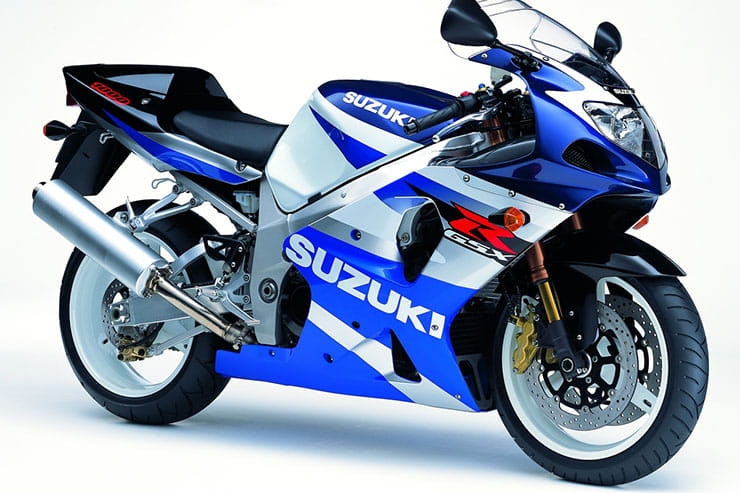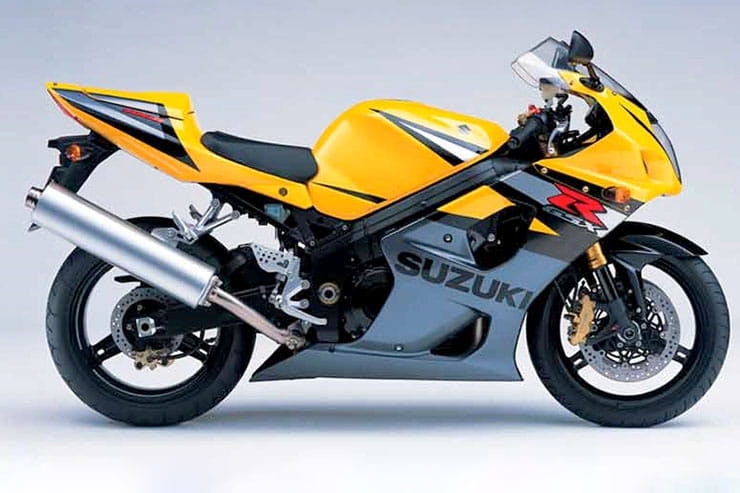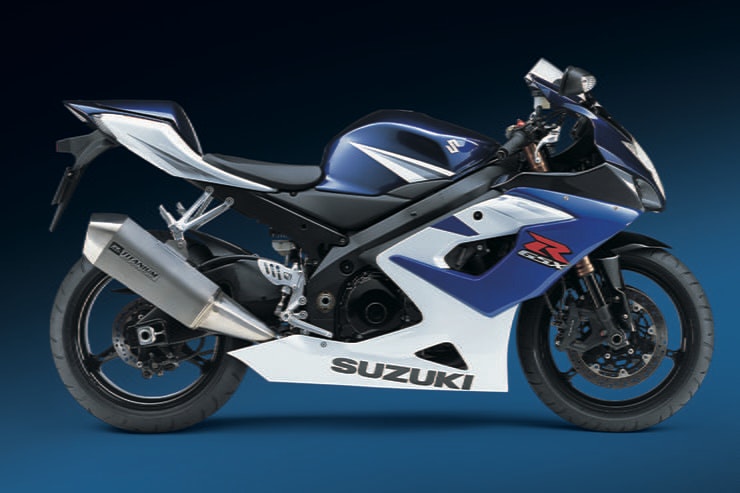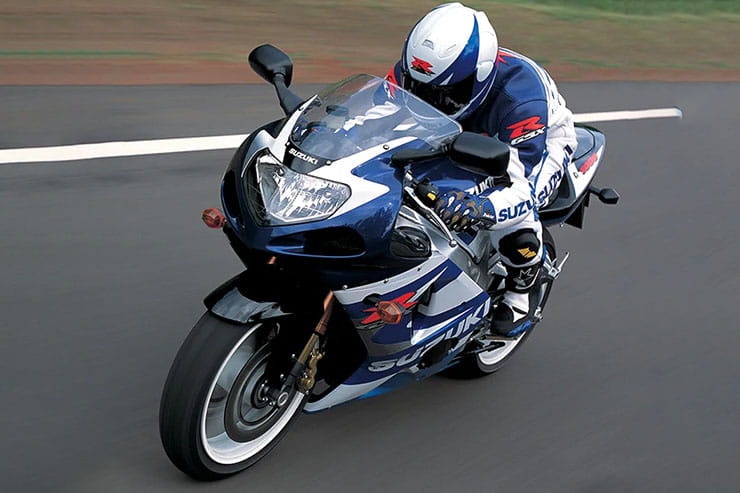Suzuki GSX-R1000 K1-K6 (2001-2006): Review & Buying Guide
By Jim Moore
Bike journo for a quarter of a century
19.07.2023
Price: £4500-£7000 (mint) | Power: 160-178bhp | Weight: 170-166kg | Overall BikeSocial Rating: 5/5
Suzuki’s GSX-R1000 turned everything up to 11 when launched in 2001. Claiming an extra 12bhp and 7 kilos less weight than that year’s R1, the Hamamatsu firm’s then flagship sportsbike and new head of the GSX-R dynasty really put the Yamaha in its place – a staggering feat given that we’d only just calibrated our brains to the YZF’s immense performance.
Indeed the 1000 K1 was a world away from the big GSX-Rs of the 1990s – 1100cc air/old-cooled and latterly liquid-cooled behemoths backed into a corner by their outdated cradle chassis technology and ever-increasing weight. The GSX-R1000 swept aside everything that linked it to those earlier 1100s and instead took its inspiration from the firm’s mightily impressive Y2K GSX-R750Y – a three-quarter litre superbike so sharp and honed it was strong enough to run with bigger, more powerful sports bikes.
Even 20 years on from their reveal, early GSX-R1000s retain a certain bullish mystique, and they’re still mightily effective in the right hands. 160bhp is a lot of power, especially in analogue form – these Suzukis feature no electronic rider aids to tame delivery or adjust what’s on offer to the conditions at hand. Only the action of your right wrist stands between you and perhaps the most exciting, untamed engine to emerge from Japan in the last two decades. And that’s the GSX-R’s main appeal. They’re superbikes in pure, undiluted form.
Life-affirming performance and the model’s impact on the litre superbike market aside, the GSX-R1000 wasn’t particularly radical in either engineering or stylistic terms. Suzuki had already trimmed the GSX-R750Y down in terms of weight and the stumpy engine/long swingarm design, essential by then to allow big performance, sharp handling and stability to comfortably coexist, was already a tried and tested formula. Styling apes that of the 750Y which, next to the Yamaha, was conservative for the time and arguably hasn’t improved over time either. But, once you step onboard and unleash what the 988cc motor has to offer, you won’t care a hoot what it looks like.
Interest in these early 1000 models is on the rise but hasn’t yet reached the fever surrounding first-year YZF-R1s, so prices are still affordable, giving you more bang for your buck than the Yamaha in every sense. In terms of value for money – tidy examples can be had from as little as £3K – verses excitement and riding thrill, these early GSX-R1000s really are hard to beat.
Outstanding performance – still an amazing engine
170bhp will never be this affordable again
The GSX-R is no more. These 1000s are future classics
The finish isn’t great, so keeping a GSX-R looking good requires lots of TLC
Gearboxes take a hammering
K1/K2 models look a bit plain compared to equivalent R1
Suzuki GSX-R1000 K1-K6 (2001-2006) Price
Keeping ahead of the pack requires a substantial refresh every couple of years, so the period between 2001 and 2006 saw three distinctly different GSX-R1000 models appear. The original, the K1, appeared in 2001 and stayed fundamentally the same until 2003 when the revised K3 took over. Two years after that the K5 reshaped the GSX-R1000 package again. As is often the case with new models, originals, or first of type, command a premium with collectors, so K1 and K2 1000s make more coin than K3-K4s and even K5-K6s despite the later bikes’ improved spec. Traditional Suzuki blue/white colours are arguably the most desirable of all options.
K1-K2 values: Rough £2000-£3000; Tidy £3500-£5000; Mint £6500-£7000
First gen GSX-R1000s are easy to spot. Their resemblance to the GSX-R750Y is obvious. Frames and swingarms are lacquered aluminium, but unlike the 750 the 1000’s forks have gold nitride finished stanchions (see what to look for) and the front calipers are gold-coloured Tokico 6-pots. Overall geometry is the same as the 750. K2 exhaust end can polished silver instead of brushed. Colours: blue/white, silver/graphite, red/silver/black, blue/silver/black.
K3-K4 values: Rough £1800-£2800; Tidy £3000-£4000; Mint £4500-£5200
First major update. Sharper styling – more pointed fairing and angled seat unit. New frame with ribbed spars, finished in black. Minor engine tweaks result in a couple of extra bhp plus a touch more torque, and chassis changes shed 2kg from overall weight. Fork stanchions now finished with black nitride. Colours: blue/white/black, burnt red/black, silver, black/gold, yellow/graphite, blue/silver/black.
K5-K6 values: Rough £2500-£3200; Tidy £3600-£4500; Mint £5000-£5500
Lighter (by a further 2kg, at 166kg), more powerful (by a whopping 16bhp, at 178bhp, by increased compression, larger throttle bodies – up 2mm to 44mm, titanium valves, plus a slight capacity increase from 988cc to 998.6cc thanks to 1.3mm wider bores), and more compact (5mm less wheelbase and overall width pinched by several mm). New chassis – still painted black – and revised styling with faired-in rear indicators and front winkers incorporated into the mirrors. Gear ratios between the tall first and sixth were tightened, six-pot calipers dropped for radially-mounted 4-pot Tokicos. Oval titanium silencer. Colours: white/blue/black, yellow/black, graphite/black/red, graphite/black, red/black.
Suzuki GSX-R1000 K1-K6 (2001-2006) Engine and Performance
The GSX-R1000 K1’s design team were the same engineers behind the GSX-R750Y so, unsurprising, the two bikes share many similarities. The 1000’s engine architecture is based heavily on the 750’s; same inline four, DOHC, 16v layout with a right-side cam chain, stacked gearbox and fuel-injection system.
Capacity fell slightly short of the litre mark at 988cc with a 73mm bore, which helped minimise the engine’s width (Suzuki later widened the bores by 1.3mm on the K5 model to increase displacement to 998.6cc). A further concession to compactness came in the shape of the aforementioned right-side cam chain.
The forged pistons were lighter than those used in the 750 (by 3 grams a piece), while the cylinders were coated with Suzuki’s patented nickel-phosphorous-silicon-carbide coating to reduce friction and therefore heat. The unit’s weight was kept to a minimum by the liberal use of magnesium componentry – covers for the cam, clutch, starter, alternator and front sprocket were all made from the material.
With a 16-bit ECU on board to control ignition timing, mixture flow, air intake and throttle opening, plus the benefit of Suzuki’s SRAD forced air intake system, performance was a claimed 160bhp at 10,800rpm and 81.8lb.ft at 8500rpm – enough for 175mph-plus in the right conditions. Performance is rapid and the motors are generally reliable and strong is well looked after.
Suzuki saved radical changes to the GSX-R1000’s engine until the 2005 K5 model which, as already mentioned, gained 11cc by the bores being widened by 1.3cc. New pistons increased compression to 12.5:1, for a stronger, improved burn fed by larger 44mm (2mm up) twin body injectors. Lighter titanium valves allowed higher rpm – peak power up considerably to a claimed 178bhp at 11,000rpm, while torque also benefitted with a lift to 87lb.ft but at the same 8500rpm.
Suzuki GSX-R1000 (2001-2006) Handling & Suspension
Like its engine, the GSX-R1000’s chassis follows the 750Y’s lead. Suzuki claimed that the riding position – seat, peg, bar position – apes that of the smaller machine. Indeed, seat height (830mm), wheelbase (1410mm), overall width (715mm), overall height (1135mm) and ground clearance (130mm) are identical. Even the rake and trail (24°/96mm) match. The frame spars feature thicker outer walls than the 750, however, and the front end differs from the three-quarter litre machine in using gold nitride coated fork stanchions and six-pot brake calipers.
Handling is generally sweet, but race teams found that despite Suzuki’s claims that the chassis of the 750 and 1000 are identical, the litre bike didn’t handle or steer as well as the smaller bike on track. The bigger, slightly heavier engine is the culprit, but on the road and on trackdays in the hands of mere mortals the 1000’s handling is just fine. The K3/K4 and K5/K6 address the issues of the K1/K2 and handle brilliantly.
Both K3/K4 and K5/K6 models got new chassis – redesigned frames and swingarms (Suzuki dropped the aluminium colour from the K3 in favour of black for both frame and swingarm), and finally did away with the fickle and expensive to service six-pot calipers in favour of radially mounted four-pots from the K5 onwards.
Suzuki GSX-R1000 (2001-2006) What to look for
GEARBOX: Take a test ride of any GSX-R you’re considering buying. Accelerate hard in second and third – if it jumps out of gear the engagement dogs could be worn or selector forks bent. K3/K4 models can suffer from rumbling clutches.
ENGINE: Robust, well-engineered and updated every couple of years. On-time oil changes are an absolute must – we’ve seen GSX-R1000s require fresh big-ends after less than 30,000 miles on bikes that have been used hard but lazily serviced.
HEAVY ON TYRES AND CHAINS: With between 160-180bhp and 80ishlb.ft on tap, any GSX-R1000 is going make rear tyres and final drives work for their living. So be mindful of how much life is left in both when looking at a potential purchase. Likewise, inspect head bearings which get a hard time from ham-fisted wheelies.
FINISH: GSX-Rs don’t respond well to neglect or slap-dash ownership. Panel paint chips all too easily, decals can peel away (a known issue on K3/K4 models), and corrosion doesn’t need a second invite to do its worst on exposed metal surfaces. K1/K2 frames and swingarms are lacquered alloy; once the protective surfaces wears away it quickly looks tatty. The gold titanium nitride on the fork stanchions wears away. Only a recoat will restore the finish.
FUEL PUMP FAILURE: Modern fuel is the bane of fuel systems and on GSX-Rs fuel pumps can fail as a result – the FI light on the dash will be your first warning. Fuel pump relays can also fail, which is a considerably cheaper fix – £25 as opposed to almost £800…
MORE POWER: GSX-Rs respond well to tuning. The easiest way to release a few more ponies (if you really do need more than 170bhp on an analogue superbike…) is with a freer breathing pipe – go for a quality brand like Akrapovic, Yoshimura, Arrow etc – and a power commander/ECU reflash. A few extra quid spent on dyno set up will fill out the power curve beautifully, doing away with any emissions related dips and troughs.
PREVIOUS OWNERS: GSX-Rs are a magnet for speed-crazed loonies (nothing wrong with that) and those who can’t leave a perfectly good superbike as standard. Consequently, crash damage, bodged repairs and acres of aftermarket tat are genuine issues for any potential buyer. Firstly, check the bike’s not bent – is the subframe inline, does it steer straight? A HPI check is your friend here. If the bike’s good but wearing a non-standard pipe, undertray, mini winkers, fake carbon etc, get the standard parts thrown in with the deal because they won’t be cheap to replace.
Suzuki GSX-R1000 K6 (2006) Rivals
Honda, CBR1000RR Fireblade, 2006 | Approx Value: £3000-£6000
Power/Torque: 172bhp/85lb-ft | Weight: 176kg (dry)
Stylish superbike with under-seat exhaust and HRC-look swingarm. Electronic steering damper aids excellent stability. Not the lightest or more powerful in class but still a looker, especially in Repsol rep paint, with great performance and handling to boot.
Kawasaki, ZX-10R, 2006 | Approx Value: £2800-£5300
Power/Torque: 175bhp/85lb-ft | Weight: 170kg (dry)
The ‘wheelbarrow’. Awkwardly styled and disappointing after the early, stripped-down and animalistic ZX-10Rs. Easier on the pocket than an equivalent GSX-R, ’blade or R1 due to this model’s lack of popularity. Go for a pre-2006 or 2008 model if it really has to be a ZX-10R.
Yamaha YZF-R1, 2006 | Approx Value: £3500-£6500
Power/Torque: 174bhp/77lb-ft | Weight: 174kg (dry)
Last R1 to feature a 20-valve head. Immense performance but as a package it requires that bit more work to get the best out of compared to the Suzuki or Honda. Arguably the most handsome litre superbike of the era, pulling off the underseat look better than any other marque. Comes with a 1:1 power to weight ratio, too.
Suzuki GSX-R1000 K1-K6 (2001-2006) Verdict
Suzuki’s early GSX-R1000s may not have the alluring style of Yamaha’s YZF-R1 or the lineage of Honda’s FireBlade, but in terms of pure, exhilarating performance and value for money the K1 through to K6 are hard to beat.
In terms of bang for your buck a K5/K6 is the one to go for – best chassis and an engine that’s still the basis of Suzuki’s retro/street range even now. One of the greatest thrills of these GSX-Rs is the fact their colossal performance isn’t diluted by electronics. What you put in at the throttle is exactly what you get out at the rear tyre; and it’s a lot.
Condition is everything when buying a GSX-R – any GSX-R. Previous owners often leave their mark in terms of nasty bolt-on extras and/or crash damage, so take your time and seek out a bike that’s been through as few hands as possible, and ensure than those hands have treated the bike with the respect it deserves. As superbikes rapidly become more and more computer controlled, these last-stand analogue powerhouses will become even more desirable. So buy now.
Suzuki GSX-R1000 K6 (2006) – Technical Specification
Looking for motorcycle insurance? Get a quote for this motorbike with Bennetts bike insurance



